Strengthen Your Core Properly With These 3 Exercises
Posted by Josh Lewis on January 31, 2019
Ever have pain in the front of your hip or low back while performing core exercises?
While your goal may be to build your abs or to strengthen your core to help your low back, improper execution of an exercise could cause you to not work the abs to their full extent or it could even be making your low back problem worse! In most cases the main culprit in this is the hip flexor. The hip flexor is involved in flexing at the waist and is located in the front of your hip. It connects from the top of your thigh, runs through your body, and connects to your low back.
The hip flexor is also located close to the abs. Because of this I often times see people improperly execute an exercise which results in more work being done by the hip flexors and not enough being done by the abs. By using the hip flexors it helps the movement seem easier and helps to (improperly) accomplish more reps. Some may argue that they still feel it in their abs, but that is because their abs are stabilizing during this movement with the hip flexors doing all the real work.
Here are three simple core exercises that I often see performed wrong in the gym and how to do them properly:
Ab Crunch
With all the crazy core exercises out there many people probably think they’re way beyond it, but I bring my clients back to a simple ab crunch.
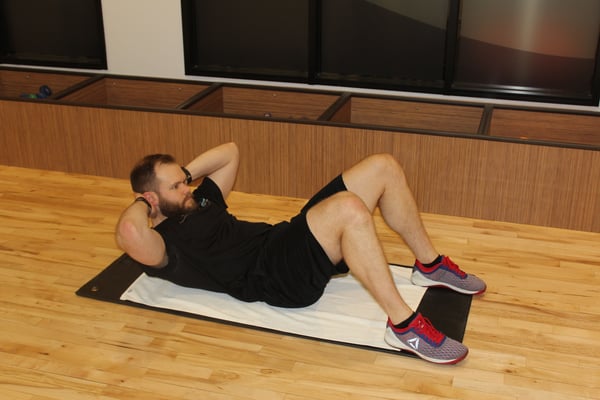
- Start out lying on your back, knees bent to 90 degrees. Place your hands wherever they feel most comfortable: across your chest, next to your head or behind your neck. Just make sure not to pull with your arms, which put strain on your neck, or to use your arms for momentum.
- Begin the crunch by pushing your lower back flat against the ground, this will shift your hips and engage your core.
- Start to raise your shoulders off the ground by thinking of trying to touch your ribs to your hips, keeping your low back pressing into the ground.
- Your body should curl up off the ground, one vertebrae at a time. The goal here is to only get your shoulder blades off the ground, resulting in only the abs working. Going any higher will begin to engage your hips. Breathe out as you raise your body off the ground, this will give you more space in your torso to crunch.
- Once you’ve reached the top, descend back towards the ground by returning one vertebrae to the floor at a time. Breathe back in as you lower towards the ground.
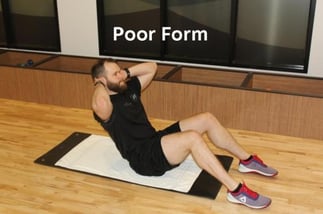 A common mistake I often see during sit-ups is a lot of flexion at the waist (the hip flexor) and a straight back with no flexion in the stomach/lumbar spine area (where your abs are).
A common mistake I often see during sit-ups is a lot of flexion at the waist (the hip flexor) and a straight back with no flexion in the stomach/lumbar spine area (where your abs are).
Perform 8-10 reps then rest. If you feel this is too easy for you, try holding the contraction at the top of crunch for a few seconds or longer, that should get those abs working!
Plank
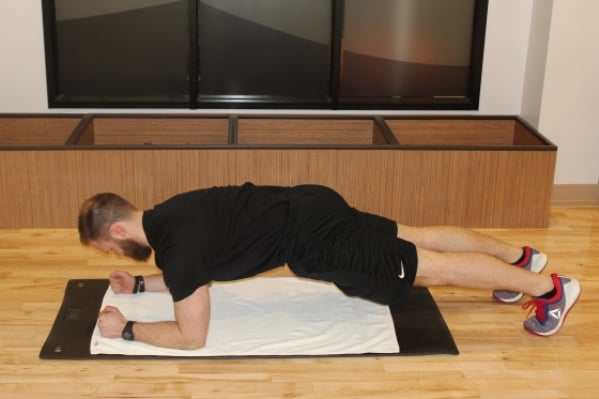
- Start out in the universal plank position: Elbows on the floor beneath your shoulders, toes on the floor and your body is flat.
- In this position the core is working, but the body likes to cheat a little by giving some of the work to your hip flexors also. To fix this, think of tucking your tailbone underneath your body, while keeping your body flat. This will engage your glutes and you should feel your core fire more also.
- From here squeeze your core as much as possible, as if you were bracing your stomach right before someone were to punch you there. Make sure to continue to breathe throughout the exercise.
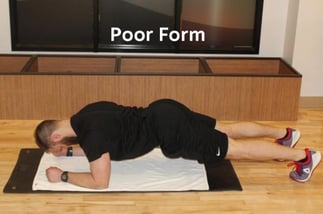 Many times I will see the glutes unengaged and the butt sticking up just a little. If this is the case, while you may once again feel your core working, chances are your hip flexors are doing more of the work. By engaging the glutes it helps to turn the hip flexors off and make sure that your body is perfectly flat.
Many times I will see the glutes unengaged and the butt sticking up just a little. If this is the case, while you may once again feel your core working, chances are your hip flexors are doing more of the work. By engaging the glutes it helps to turn the hip flexors off and make sure that your body is perfectly flat.
If the normal plank position is too easy for you, try moving your elbows further in front of you and follow the same cues as the regular plank. Hold for the desired time length that fits your skill level.
Bird Dog
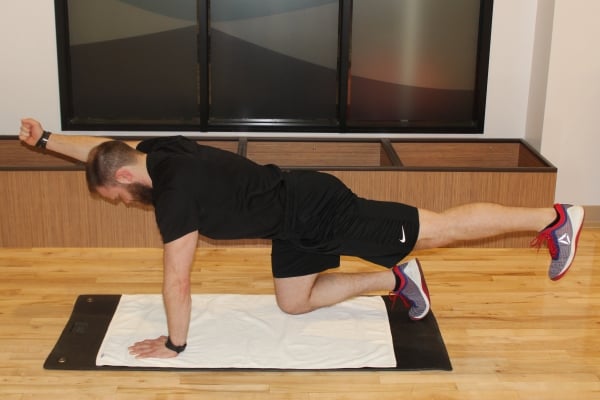
The bird dog is an excellent exercise to train your core to help stabilize your low back. While the hip flexors aren't as involved in this exercise, it is still one that I see performed improperly. During this exercise I often observe too much of an arch resulting in the low back doing too much of the work.
- Start in a table top position: arms straight with wrists directly below your shoulders, knees beneath your hips. Your neck should be in a neutral spine, roughly staring at the floor, and your ribs should be flush with your body so that your low back is not arched.
- For the motion we will be using the opposite arm and leg (right arm and left leg, or left arm and right leg). Start by making a fist with one hand and punching straight forward, arm fully extended, so that your bicep ends up next to your ear. Perform the punch while simultaneously kicking backwards towards the wall with the heel of your opposite leg, causing your leg to fully extend.
- You should try to keep a constant line of tension through your body starting at your fist and arm, all the way though your upper and lower back, glutes and down through your leg, resulting in your body being perfectly flat.
- One key to this exercise is to focus on keeping your ribs flush with your body; this will keep your core engaged and teach it to stabilize your low back. If possible, hold this tensed position for a count of 3-5 seconds, or longer if this is easy for you. Then return your limbs to the ground in a controlled manner and perform the same movement with the other arm and leg. Perform 3-5 repetitions for each side, depending on the difficulty of the exercise for you.
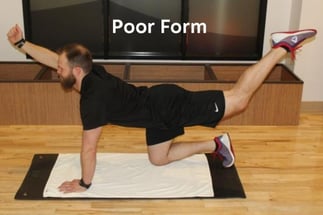 One fault I often see during this movement is an overreaching of the arm, leg or both in an upwards motion. This results in a curve in the low back which causes the core to under work and places extra stress on the low back. A way to make sure you are in proper form is to imagine that there is a dowel lying on top of your back. Your goal is to keep all parts of your back touching the dowel. Also if you do the movement too fast or perform an over exaggerated arch this would cause the dowel to fall off.
One fault I often see during this movement is an overreaching of the arm, leg or both in an upwards motion. This results in a curve in the low back which causes the core to under work and places extra stress on the low back. A way to make sure you are in proper form is to imagine that there is a dowel lying on top of your back. Your goal is to keep all parts of your back touching the dowel. Also if you do the movement too fast or perform an over exaggerated arch this would cause the dowel to fall off.
Strengthening your core can make a big difference in your overall fitness level as it is involved in almost every exercise performed in the gym. However, if done incorrectly, core exercises can cause extra problems by tightening and placing stress on areas that will make you more susceptible to an injury. The next time you’re working on your core try adding these exercises and cues and see what a difference it makes in properly strengthening your core and relieving unneeded stress on your low back and hips!
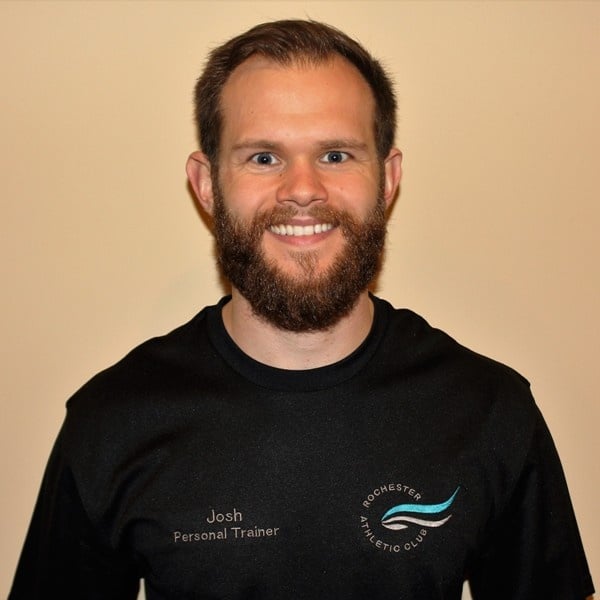
Josh Lewis
Personal Trainer Josh Lewis M.Ed., NSCA CSCS has a Bachelor’s degree in Kinesiology from UW-Eau Claire and a Master’s degree in Kinesiology from the University of Minnesota. When he’s not at the gym he enjoys hiking, camping, fishing, hunting and watching sports with family and friends. Josh’s love for being active, along with the enjoyment he receives from helping people reach their goals, is what led him to become a Personal Trainer.
Contact Josh Lewis at (507) 287-9335 ext. 351.
